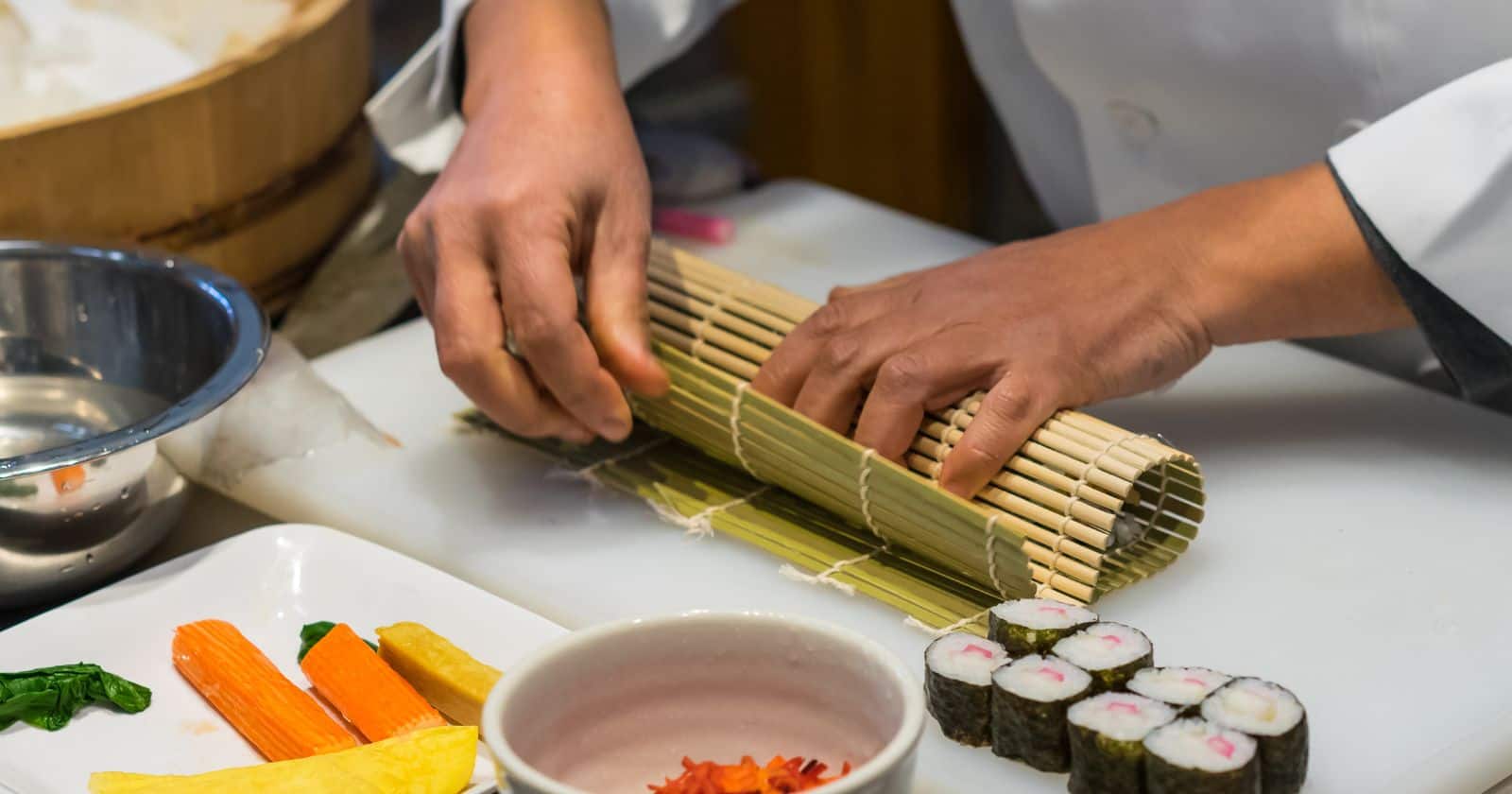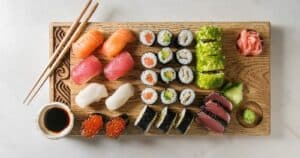Sushi rolls, a delicious fusion of Asian and Western flavors, are intricate creations made from several key ingredients. But what exactly are the components that go into crafting these iconic rolls? Let’s unravel the mysteries of sushi rolls and the ingredients that make them sing.
Rice is the foundation of sushi rolls. Sushi rice has a short, plump grain that, when cooked with rice vinegar, sugar, and salt, becomes sticky and slightly sweet. This allows the rice to cling together and support fillings.
Nori seaweed sheets lend structure and define the rolls’ iconic cylindrical shape. Dark green and crisp, nori wraps the rice and fillings into a tidy bundle.
As for fillings, the possibilities are endless! Classic rolls feature raw fish like tuna, salmon, yellowtail, shrimp, or crab. Cooked ingredients like egg, avocado, cucumber, and carrot also frequently make appearances.
Finally, condiments like wasabi, pickled ginger, and soy sauce add a kick of flavor. Briny, spicy, and tangy all at once!
Now that you know the key ingredients, it’s time to head to your local sushi spot and appreciate these complex rolls in a whole new way. Read on to learn insider tips for selecting and enjoying sushi like a pro!
Sushi Rice – The Foundation
The foundation of all sushi rolls is the sushi rice. This short-grained white rice is steam-cooked, then seasoned with a sweet and tangy dressing made from rice vinegar, sugar, and salt.
The vinegar dressing causes the rice grains to cling together, while also imparting a subtle sweet-sour flavor. This sticky, starchy rice is essential for holding the roll together and supporting the fillings.
Without properly made sushi rice, the roll would fall apart instantly!
Crafting Perfect Sushi Rice
Cooking the ideal sushi rice takes some finesse. Here are a few tips:
- Rinse the rice several times before cooking to remove excess starch. This prevents the grains from getting too gluey.
- Cook the rice with a bit less water than usual. The grains should be firm and separated.
- Season the hot rice with the vinegar dressing. Mix thoroughly to evenly distribute.
- Allow the seasoned rice to cool before making rolls. The sticky texture develops as it rests.
Mastering sushi rice takes practice, but this foundation is key to roll success!
Nori – Wrapping It Up
The next vital component of sushi rolls is nori. These paper-thin sheets made from dried seaweed provide the wrapping that forms the rolls.
Nori has a glossy black-green hue and toasty, ocean-like aroma. When briefly toasted, the sheets become pliable yet crisp — perfect for encasing the rice and fillings inside a roll.
The nori’s papery texture holds the contents together in a tidy cylindrical shape. Its savory umami flavor also complements the fillings.
Look for pre-toasted nori sheets for easy sushi rolling at home. With the right technique, nori wraps up all the ingredients into compact, bitesize morsels.
Fillings – Endless Possibilities
Here’s where sushi rolls really get creative! The filling possibilities are endless, giving this dish incredible versatility.
Fillings fall into two main categories:
Raw Seafood
The most traditional sushi roll fillings are raw fish and seafood. These include:
- Tuna – rich, meaty flavor
- Salmon – silky, buttery texture
- Yellowtail – mild, mellow taste
- Shrimp – sweet and briny
- Crab – delicate, flaky meat
- Squid – chewy, salty bites
- Eel – smoky, rich flavor
Raw seafood is sliced into long strips and layered within the roll. Look for ultra-fresh, sashimi-grade fish for the best flavor and texture.
Cooked Ingredients
In addition to raw fish, sushi rolls often contain cooked ingredients too:
- Tamago – sweet rolled omelet
- Cucumber – cool, crunchy texture
- Carrots – vibrant color, gentle sweetness
- Avocado – rich, creamy addition
- Shiitake mushrooms – meaty, earthy flavor
- Cream cheese – rich, tangy accent
Cooked proteins like grilled eel and shrimp tempura also make tasty additions. Vegetable or veggie rolls use cooked ingredients to create meatless options.
The cooked components provide contrasting temperatures, textures, colors and flavors.
Condiments – Finishing Touches
No sushi roll is complete without a few finishing touches from condiments and garnishes.
- Soy sauce – the traditional dip, balancing salty, sweet, and umami
- Wasabi – fiery green horseradish, clears the palate
- Pickled ginger – tart, slightly sweet, cleanses between bites
- Sriracha – for spicy rolls, adds a chili kick
- Tonkatsu sauce – savory-sweet with Asian flavors
- Teriyaki sauce – lightly glazes and lacquers ingredients
- Sesame seeds – nutty crunch and visual appeal
- Furikake – dry Japanese seasoning with sesame, seaweed, fish flakes
- Tempura crumbs – crispy texture and dynamic crunch
Drizzling, dusting, or dolloping on the condiments takes each roll to the next level. Play around and discover new flavor combinations!
Constructing Rolls Like a Pro
Now that you know the core ingredients, it’s time to start constructing sushi! Making professional-looking rolls is easier than you think. Follow these simple steps:
1. Prepare the Rice and Nori
Cook fresh sushi rice and allow it to cool completely. Cut nori sheets in half widthwise.
2. Line the Nori
Place a nori sheet on a sushi rolling mat, shiny side down. Spread rice evenly over the sheet, leaving a 1⁄2 inch border uncovered.
3. Add Fillings
Layer your desired fillings across the center of the rice. Don’t overstuff – leave room to roll!
4. Roll It Up
Lift the front edge of the mat over the fillings and tuck it under tightly. Apply gentle pressure as you roll away from yourself.
5. Seal the Deal
With the filled roll on the mat, apply pressure to shape it. Brush the open edge with water and close the roll seam.
6. Slice and Serve
Trim the ends off the roll and cut into 6 or 8 even pieces. Arrange artfully and serve with condiments!
It takes a little practice, but your sushi rolls will improve each time. Don’t worry about perfection – embrace the process!
Trying New Sushi Roll Combinations
Once you’ve mastered the basics, the fun really begins! You can customize rolls with limitless flavor combinations.
Play With Textures
Mix up the textures within a roll. Contrast soft and creamy with some crunch:
- Salmon, avocado, cucumber
- Shrimp tempura, tamago, Cucumber
- Tuna, carrot, tempura crumbs
Pair Complementary Flavors
Combine ingredients with complementary or contrasting flavors:
- Spicy tuna, cool cucumber, creamy avocado
- Eel, avocado, sweet tamago
- Crab, mango, jalapeno for sweet heat
Theme It Up
Go all out on a theme, like:
- Mexican – spicy tuna, avocado, sriracha, cilantro
- Hawaiian – shrimp, mango, pineapple, teriyaki glaze
- Veggie lover – shiitake, spinach, avocado, cucumber, carrot
Color Coordinate
Make visually stunning rolls with vibrant colors:
- Red: tuna, chili powder, beet, avocado
- Green: cucumber, avocado, wasabi, arugula
- Orange: salmon, mango, carrots, masago
Key Takeaways on Sushi Roll Ingredients
We’ve uncovered all the components that go into crave-worthy sushi rolls. Here are the key takeaways:
- Sushi rice binds it all together. Cooked with vinegar, sugar and salt, it becomes sticky, sweet, and tangy.
- Nori seaweed sheets wrap the rice and fillings into rolls. Crisp, toasty, and full of umami.
- Fresh and cooked meats, seafood, veggies, eggs, etc. provide endless filling options.
- Condiments like wasabi, ginger, and soy sauce accentuate the flavors.
- With the right technique, you can construct beautiful sushi rolls at home.
- Customize rolls with fun combinations of flavors, textures, colors and themes.
Now put this sushi intel to use on your next homemade sushi night! Impress those taste buds with your newfound knowledge and rolling skills.





